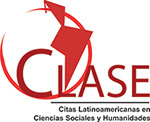Modelos matemóticos aplicados a las redes de comunicación
DOI:
https://doi.org/10.23857/dc.v7i3.2027Palabras clave:
Modelos matemáticos, redes, comunicación, redes inalámbricas.Resumen
Este trabajo presenta una investigación de la aplicación de los modelos matemóticos en las redes de comunicación. A través de una revisión bibliogrófica de la literatura pertinente en las principales bases de datos tales como SCOPUS, BASE y Google Scholar de los íºltimos años se ha encontrado información relevante. Se toma como ejemplo el calentamiento de agua helada utilizando un data logger Pro 3, y se obtiene que un modelo matemótico puede calcular el menor níºmero de nodos para alcanzar una determinada fracción de cobertura. En conclusión, los modelos matemóticos imponen una influencia sustancial en las redes de comunicación.
Citas
Alasuutari, P. (2010). "The rise and relevance of qualitative research". International Journal of Social Research Methodology. 13 (2): 139–55. doi:10.1080/13645570902966056. S2CID 143736805
Ang, K.C. (2006a). Mathematical Modelling, Technology and H3 Mathematics, The Mathematics Educator, 9(2), 33-47. Ang, K.C. (2006b). Differential Equations: Models and Methods. McGraw-Hill, Singapore.
Ang, K.C. (2009). Mathematical Modelling in the Secondary and Junior College Classroom, Singapore: Prentice-Hall.
Ang, K.C. (2010). Mathematical Modelling in the Singapore Curriculum: Opportunities and Challenges, In Proceedings of the Educational Interface between Mathematics and Industry Study Conference, Lisbon, Portugal, pp. 53-61.
Arndt, M., Juffmann, T., & Vedral, V. (2009). Quantum physics meets biology. HFSP J, 3(6), 386-400.
Babbie, E. (2014). The Basics of Social Research (6th ed.). Belmont, California: Wadsworth Cengage. pp. 303–04. ISBN 9781133594147. OCLC 824081715
Blum, W. & Ferri, R.B. (2009). Mathematical Modelling: Can it be taught and learnt? Journal of Mathematical Modelling and Application, 1(1), 45-58.
Clare, D. K., Pechnikova, E. V., Skurat, E. V., Makarov, V.V., Sokolova, O. S., Solovyev, A. G., & Orlova, E.V. (2015). Novel Inter-Subunit Contacts in Barley Stripe Mosaic Virus Revealed by Cryo-Electron Microscopy. Structure. ISSN1878-4186 (Electronic)
Fan, X. (2013). PhD Dissertation: A Generalized Noisy Communication Channel Approach For Quantum Computing. The University of Alabama at Birmingham.
Pan, L., & Patterson, J. C. (2013). Molecular dynamics study of Zn(abeta) and Zn(abeta)2. PLoS One, 8(9), e70681.
Pernecky, T. (2016). Epistemology and Metaphysics for Qualitative Research. London: SAGE Publications.
Reymond, J. L., & Awale, M. (2012). Exploring chemical space for drug discovery using the chemical universe database. ACS Chem Neurosci, 3(9), 649-657.
Seker R., Tanik M. M. (2004). An Information-Theoretical Framework for Modeling Component-Based Systems. IEEE Transactions on Systems, Man, and Cybernetics, 34, 475-484.
Warwick, J. (2007). Some Reflections on the Teaching of Mathematical Modelling, The Mathematics Educator, 17(1), 32-41.
Wu, Z. (2008). Mathematical modelling of the data transmission system in communication networks, Aviation, 12:1, 18-21, DOI: 10.3846/1648-7788.2008.12.18-21
Publicado
Cómo citar
Número
Sección
Licencia
Authors retain copyright and guarantee the Journal the right to be the first publication of the work. These are covered by a Creative Commons (CC BY-NC-ND 4.0) license that allows others to share the work with an acknowledgment of the work authorship and the initial publication in this journal.






